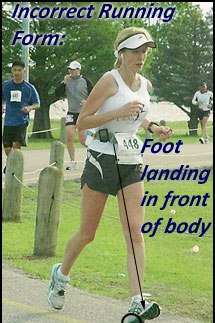In past articles, we’ve looked a lot at what good form “looks like,” objectively speaking.
You don’t want your hips dropping on footstrike, or your legs crossing over the center of your body, or your stride frequency to be too low. But all of these are tough to actually measure yourself.
While there are a few tricks you can use, like counting footstrikes through a puddle and checking your footprints, performing running-specific strength and form drills and using a video camera, none of these are particularly useful when you are actually out in the real world on a run. Today, we’ll take a somewhat unscientific look at running form. This time, we’re asking: “what does good form feel like?”
What is good running form
While there is no such thing as “ideal” running form, most runners can identify an athlete with an efficient stride. An economical runner is relaxed, smooth, quick, powerful, and light on his feet—he seems to float over the ground with ease.
In contrast, an inefficient stride looks labored, sloppy, and uncoordinated. These same qualities that define an efficient stride also make good mental cues. Thinking about relaxing or being light on your feet is very helpful towards improving your stride.
The gait cycle
To sort out how all of these different qualities fit into your own stride, it helps to break down running into its most basic unit: the gait cycle.
One gait cycle begins as your foot (in this example, your right foot) hits the ground, marking the footstrike. Depending on your footstrike style, either your heel or your forefoot hits the ground next, marking the transition to the stance phase.
As your right leg absorbs the impact forces, it transitions into actually generating force. This is the drive phase.
As your right foot leaves the ground, your left leg is in the swing phase, moving through the air like a pendulum, unfolding underneath your body with the foot extending toward the ground. The same footstrike, stance, and drive phases occur on the left leg while the right leg swings through the air. As the right foot approaches the ground again, the gait cycle ends.
So, we are left to sort out exactly where these subjective stride qualities fit into the gait cycle.
The footstrike should be light and quick: whether you heelstrike or forefoot strike, your foot should not be extended far out in front of you with a locked knee. You will find that this feels neither light nor quick. 
As you transition to the stance phase, you should focus on moving as rapidly to the drive phase as possible. While objectively speaking, the stance phase cannot be eliminated, it helps to think of your footstrike as transitioning immediately from hitting the ground to driving off of it. Again, having your foot hit the ground close to your center of mass instead of far out in front of it will facilitate this.
The power in your stride should come during the drive phase. Too many runners try to extend their stride by reaching forward with their leg during the swing phase; instead, you want to focus on driving your leg straight behind you using your hips.
However, when you are running at easy to moderate paces, sometimes thinking about generating power can be counterproductive.
Instead, you can think about “floating”: using hip extension and a quick cadence to make your body feel as if it were just gliding along the road. As your foot leaves the ground, resist the temptation to “pull through” and extend your knee immediately.
The swing phase is the time to think about relaxing. Simply let your leg swing underneath you and unfold beneath your body.
With a little experimenting, you will find that driving your leg behind you with your hips will result in a smooth swing-through and high back-kick (how closely your heel comes to your butt) on the opposite leg. So, focusing on driving off with your left leg will result in your right leg kicking back high and swinging through smoothly, and vice versa.
How to practice good running form
Actually practicing and incorporating these mental cues into your running is not always easy. It’s hard to practice running smoothly and efficiently if you are running a tough workout or are on a busy road. The best place to practice becoming a lighter, smoother, and more efficient runner is along a flat, straight, and isolated path. Bike paths through parks or “rails-to-trails” projects are great. You want to be able to tune out everything else and focus on being relaxed, smooth, efficient, and quick. And, if you are practicing running fast, you want to be focused on generating power too. I find it best to separate these two: try to do some runs where you practice relaxation, smoothness, lightness, and efficiency, then later incorporate power and quickness in some short repetitions at a faster pace to improve your speed-economy.
For most runners, improvements in your speed will not come from all-out sprint work or gut-churning intervals, but from learning to relax while running fast. Many runners like to tack on a set or two of strides, repeats of 100-150m at a reasonably fast pace with an equal jog recovery to improve their efficiency.
Another workout I like for improving the power- and quickness- end of the efficiency spectrum is diagonals, a favorite of Kenyan runners. To run diagonals, all you need is a soccer field. Run from one corner to the other fast, then jog along the sideline to the next corner, then cross over again. Usually this is done for time—so, for example, you might do 15min of diagonals in the middle of a 45min run.
In lieu of a formal conclusion, I’ll close with a running form “cheat sheet” that I developed for my college team. It’s a short, simple list of things you can keep in mind when you are doing strides, diagonals, an interval workout, or just going out for an easy run.
Running Form Cheat-Sheet
- Everything relaxed, smooth, quick, and efficient
- All energy goes towards forward propulsion
- Balanced side-to-side
- Lower Leg: don’t “reach”—let leg “unfold” underneath you
- Foot lands nearly underneath center of gravity
- Knee drive and back-kick come from hip drive and extension
- Powerful “piston hips” create drive—realize forward hip DRIVE (flexion) is linked to hip EXTENSION
- Slight forward lean from ankles
- Strong arms swinging waist-to-nipple
- Stride frequency—light and quick. Shoot for ≥45 single-leg strikes in 30sec (check often)
While nobody’s got a “perfect” stride, almost everyone can benefit from working to become a smoother and more efficient runner. These changes won’t happen overnight, but they also don’t require an enormous time investment. Just a few minutes each time you’re out running will go a long ways toward becoming a better runner.





One Response
In thinking about hip extension and drive, from what part of the femur does this come? When running I can “feel” either driving from the knee (backwards) or from the femoral head (this feels like it makes more sense, but seems to come close to over-extending the knee as it moves rearward). I assume one is hamstrings the other is glutes, it must be some combination. Is there a way to get a feel for this? Are the hips rotating (crest moving forward and backward) or should they be fixed (think: POSE where hips rotate around L5)? With the hips being so important, could you describe how to feel proper hip motion, please? Thank you! –Ian